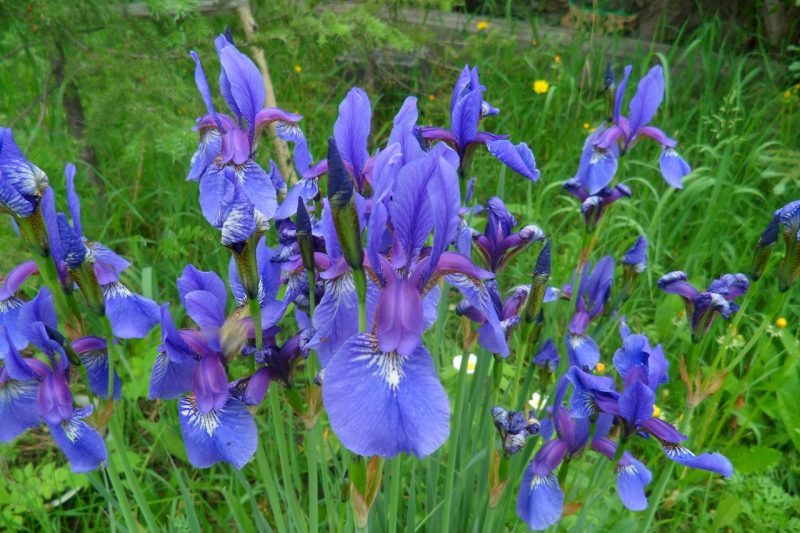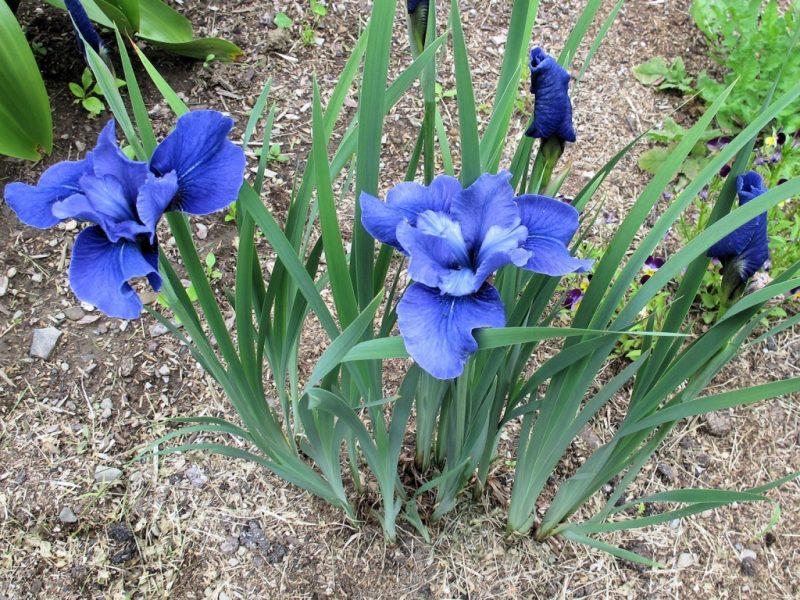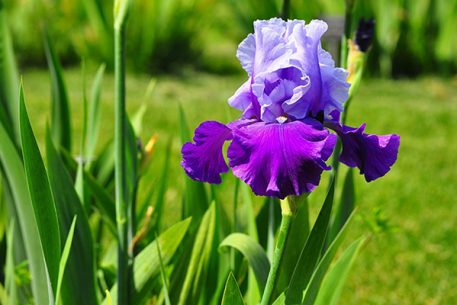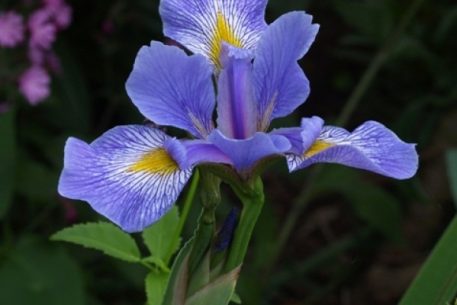A garden surrounded by flowers is the dream of every grower. However, not everyone has enough free time and experience to fulfill the complex agrotechnical requirements for growing abundantly flowering plants. The Siberian iris from the Kasatikovy family is a bright and elegant inhabitant of urban flower beds and private flower beds, which does not require complicated care, giving a variety of shades and shapes.
Material Content:
Description of the species and varieties
Siberian iris is a species of perennial plants with beautiful leaves and strong stems, which even reach 120 cm do not need support. Depending on the variety, of which a large number is bred, plants may differ in height, flower shape, flowering time and color scheme.
Popular varieties of Siberian iris:
• “Alba” - a tall variety with white flowers with a purple hue. The diameter of the inflorescences, which are observed in early summer, is 6 cm.
• Bate and Shuge - medium-sized variety with two-color flowers up to 11 cm in diameter. The upper petals are painted white and the lower petals are lemon. Flowering occurs in July.
• “Double Standard” - tall representatives of the variety have large, double inflorescences up to 11 cm in diameter, which are colored in purple with a yellow core.
• “Concord crash” - blue-violet flowers with a pale yellow middle of this variety crown the tops of shoots reaching a meter height in late spring and early summer.
• “Munk Silk” - the variety is represented by petals with wavy edges of a white-yellow hue.
• “Super Ego” - a blue variety with flowers with a diameter of 14 cm blooms in early summer.
• “Shirley Pope” - a medium-sized variety with dark blue flowers, which bloom in early summer.
Siberian irises: landing
In order for Siberian irises to bloom abundantly and delight with bright colors both in the southern regions and in the north, it is necessary to correctly approach planting work.
Choosing a place and preparing the soil for planting
Since the flowers belong to photophilous plants, in the north it is necessary to give preference to sunny and warm areas. In the southern regions, it is recommended to choose slightly shaded areas of the garden, where the possibility of burns of plants from direct, midday sun will be excluded. Irises are undemanding to the ground, but they prefer to develop on fertile, slightly compacted soils with a neutral reaction. To ensure the above parameters when digging, it is enough to introduce humus and sand.
Flower planting technology
The planting procedure is carried out in the second half of spring or early autumn according to the following scheme:
1. 5 days before planting, the selected area is dug up with the simultaneous removal of weed rhizomes.
2. The distance between the holes is maintained at the level of 50-100 cm, because every year the bushes grow and become more magnificent.
3. Before planting, roots and leaf blades are shortened by ⅓.
4. Rhizomes are placed in holes and sprinkled with earth so that they are buried by 3-5 cm.
5. After completion of work, plantings are watered and mulched with peat.
Necessary Siberian irises care
Proper care, to which Siberian kasatik is quite undemanding, will provide abundant and long flowering, as well as the rapid growth of lush bushes.
Watering and mulching
It is necessary to water Siberian irises infrequently, but abundantly, so that the trunk circle is well saturated. To preserve moisture, it is recommended to cover the soil under the bushes with mulch, which will help maintain the necessary level of humidity.
Top dressing
To preserve the fertile soil layer, under planting, fertilizers should be applied twice during the growing season:
1. After snow melts in early spring, irises are fertilized with nitrogen-containing fertilizers in the form of ammonium nitrate or urea.
2. In the budding phase for abundant and prolonged flowering, specimens are fed with phosphorus-potassium agrochemicals.
Pruning
After flowering with sharp scissors flower stalks are removed. Two weeks before the frost, when the laying of flower buds for the next season is completed, foliage is also shortened to 10-15 cm. If the gardener is in doubt about the timing, then pruning the leaf plates can be transferred to early spring.
Transplantation and division of rhizomes
The transplant procedure, coupled with the most common method of reproduction - rhizome division, is carried out with an interval of 5-6 years. In the northern regions, irises should be transplanted in early spring so that they can take root. In the middle lane, a transplant can be carried out in late August and early September. Wherein:
1. Leaf plates are trimmed by ⅔ to reduce moisture evaporation.
2. Then the bush is dug up, and the rhizome is divided by a sterile knife or garden shears so that 2 sprouts remain on each delenka.
3. Places of cuts are processed by crushed wood or activated carbon.
4. Delenki land in the holes, where they are sprinkled with soil, which is compacted and watered.
Pest and Disease Control
In violation of the basic rules for care, unpretentious irises can be affected by harmful organisms.
Among the diseases on the culture, fusarium and rot are noted, upon detection of which the affected specimens are immediately destroyed, and healthy ones are sprayed with fungicide.As a preventive measure against spotting caused by a fungus, spring treatment of plantings with a Bordeaux mixture is carried out.
Also, the culture can be damaged by thrips, scoops, eating out the base of the peduncle, as well as slugs. To cope with the first two harmful insects, you can prepare a solution of an insecticide for spraying. Gastropod pests will have to be controlled mechanically.
Breeding methods
An acceptable way to propagate irises is to divide the rhizome, the procedure for which is described above. Also, when breeding, there is a certain problem associated with self-seeding due to the extremely rapid maturation of seed. However, since the seed method does not preserve the varietal quality of crops, to prevent the "degeneration" of varietal flowers, seed bags should be removed in a timely manner.
Siberian iris in landscape design
Due to the variety of varieties with a wide color palette, an abundance of shapes and sizes, irises are very popular in landscape design:
• Siberian irises of bright shades with open flowers are used by designers when decorating the first tier of a flower garden or in group plantings to shade lawns with lush greenery.
• Tall varieties with lush bushes can be a great backdrop for other plants.
• When laying a round flowerbed, tall irises are planted in the center of the flower arrangement.
• Hobbies look harmoniously along the coast of an artificial water body or along garden paths.
• Low-growing varieties in single or small group plantings often adorn rockeries and alpine hills.
Thus, for every garden there is sure to be a suitable variety of Siberian kasatika, characterized by abundant and beautiful flowering, as well as undemanding character.





















